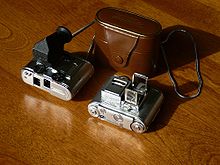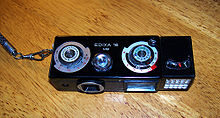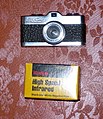
A single-lens reflex camera (SLR) is a camera that typically uses a mirror and prism system that permits the photographer to view through the lens and see exactly what will be captured. With twin lens reflex and rangefinder cameras, the viewed image could be significantly different from the final image. When the shutter button is pressed on most SLRs, the mirror flips out of the light path, allowing light to pass through to the light receptor and the image to be captured.

A twin-lens reflex camera (TLR) is a type of camera with two objective lenses of the same focal length. One of the lenses is the photographic objective or "taking lens", while the other is used for the viewfinder system, which is usually viewed from above at waist level.

135 film, more popularly referred to as 35 mm film or 35 mm, is a format of photographic film used for still photography. It is a film with a film gauge of 35 mm (1.4 in) loaded into a standardized type of magazine – also referred to as a cassette or cartridge – for use in 135 film cameras. The engineering standard for this film is controlled by ISO 1007 titled '135-size film and magazine'.
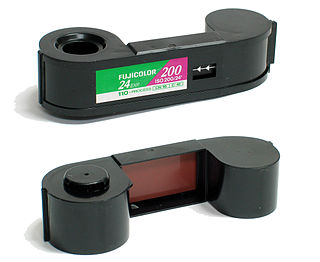
110 is a cartridge-based film format used in still photography. It was introduced by Kodak in 1972. 110 is essentially a miniaturized version of Kodak's earlier 126 film format. Each frame is 13 mm × 17 mm, with one registration hole. Cartridges with 12, 20, or 24 frames are available on-line. Production variations sometimes have allowed for an additional image.

Disc film is a discontinued still-photography film format that was aimed at the consumer market. It was introduced by Kodak in 1982.
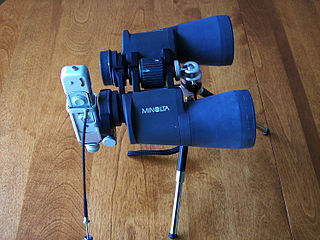
Minox is a manufacturer of cameras, known especially for its subminiature camera.
The Instamatic is a series of inexpensive, easy-to-load 126 and 110 cameras made by Kodak beginning in 1963. The Instamatic was immensely successful, introducing a generation to low-cost photography and spawning numerous imitators.

Rollei was a German manufacturer of optical instruments founded in 1920 by Paul Franke and Reinhold Heidecke in Braunschweig, Lower Saxony, and maker of the Rolleiflex and Rolleicord series of cameras. Later products included specialty and nostalgic type films for the photo hobbyist market.
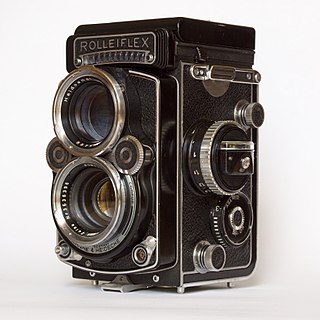
Rolleiflex is the name of a long-running and diverse line of high-end cameras originally made by the German company Franke & Heidecke, and later Rollei-Werke.

Schneider Kreuznach is the abbreviated name of the company Jos. Schneider Optische Werke GmbH, which is sometimes also simply referred to as Schneider. They are a manufacturer of industrial and photographic optics. The company was founded on 18 January 1913 by Joseph Schneider as Optische Anstalt Jos. Schneider & Co. at Bad Kreuznach in Germany. The company changed its name to Jos. Schneider & Co., Optische Werke, Kreuznach in 1922, and to the current Jos. Schneider Optische Werke GmbH in 1998.

Advanced Photo System type-C (APS-C) is an image sensor format approximately equivalent in size to the Advanced Photo System film negative in its C ("Classic") format, of 25.1×16.7 mm, an aspect ratio of 3:2 and Ø 30.15 mm field diameter. It is therefore also equivalent in size to the Super 35 motion picture film format, which has the dimensions of 24.89 mm × 18.66 mm and Ø 31.11 mm field diameter.

The history of the single-lens reflex camera (SLR) begins with the use of a reflex mirror in a camera obscura described in 1676, but it took a long time for the design to succeed for photographic cameras. The first patent was granted in 1861, and the first cameras were produced in 1884, but while elegantly simple in concept, they were very complex in practice. One by one these complexities were overcome as optical and mechanical technology advanced, and in the 1960s the SLR camera became the preferred design for many high-end camera formats.
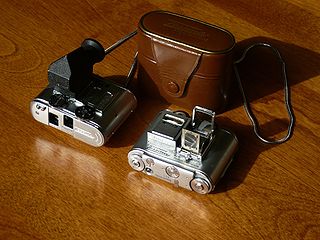
The Tessina is a high-quality 35mm camera patented by Austrian chemical engineer Dr. Rudolph Steineck in Lugano Switzerland, manufactured by Siegrist in Grenchen Switzerland. It was introduced in 1957 and distributed by Steineck's company Concava S.A and remained in production up to 1996. The Tessina takes 14x21 mm pictures on standard 35 mm film, making it one of the few subminiature cameras to use the format. It is a very small (2.5x2x1 inch) twin lens reflex, with two 25 mm f/2.8 Tessinon lenses, one for taking the picture, the other for viewing on a tiny ground-glass focusing screen on top of the camera. A 45° mirror is employed to bend incoming light onto the film, which lies along the bottom of the camera rather than the back to save space. Apertures are continuously variable down to f/22, and shutter speeds range from 1/2 to 1/500, and B. The Tessina 35, Tessina L can focus down to 9 inches, Tessina Automatic 35mm to 12 inches. The film is advanced via a clockwork master spring built into the takeup spool, with a pullout winder like the crown on a wristwatch. Each winding can last up to 8 exposures.

Minolta 16 refers to a line of 16mm subminiature cameras made by Minolta between 1955 and 1974. The negative size was 10x14 mm for the earlier models, later, a larger format, 12x17 mm was adopted, using single-perforated 16 mm film. It was possible to load your own cassettes, and also develop the film using a special developing tank with a spiral insert for 16 mm film.

The Rollei 35 is a 35mm miniature viewfinder camera built by Rollei. The original Rollei 35, when introduced at photokina in 1966, was the smallest existing 135 film camera. The Rollei 35 series remains one of the smallest 35 mm cameras after the Minox 35 and Minolta TC-1. In 30 years, about 2 million Rollei 35 series cameras were manufactured. The Rollei 35 was manufactured by DHW Fototechnik up to 2015, the successor of Franke & Heidecke as small-batch production. The last version is the Rollei 35 Classic, an updated Rollei 35 SE.

Half-frame cameras, also called single-frame or split-frame cameras, are analog cameras compatible with 35mm film types. These cameras capture congruent shots that take up half of each individual frame in the roll of film. They can be still frame or motion picture cameras and are the standard format of 35mm movie cameras. This is commonly expressed, more technically, as 18×24 mm using 18×24 mm of a regular 135 film. It is closer to the normal frame size of a 35 mm motion film. This leaves half frame cameras to derive their film plate size from the aspect ratio, and frame size that was first designated by Thomas Edison at the dawn of the motion picture industry. Traditionally, the additional film width on motion picture film is used for audio in later film standards, although the original patent for sound on film is derived from the 1880s.

Heinz Waaske was a German camera designer, notably father of the Rollei 35.

The invention of the camera in the early 19th century led to an array of lens designs intended for photography. The problems of photographic lens design, creating a lens for a task that would cover a large, flat image plane, were well known even before the invention of photography due to the development of lenses to work with the focal plane of the camera obscura.
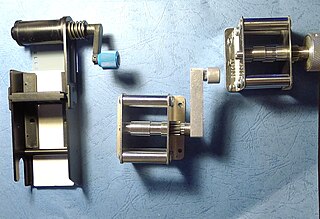
A film slitter, sometimes also called film splitter, is a device used in subminiature photography to slit 135 or 120 roll film into 16mm film or Minox film for use in subminiature cameras.

The Narciss is an all-metal 16 mm subminiature single lens reflex camera made by Russian optic firm Krasnogorsky Mekhanichesky Zavod (KMZ) Narciss between 1961 and 1965. It is the first subminiature SLR. It took 25 14×21 mm frames using unperforated specially spooled 16 mm film in a Narciss cassette. Compact design with interchangeable lenses and interchangeable pentaprism finders. The Narciss camera was initially designed for medical use, it included a Narciss with ordinary pentaprism finder and a second magnifier pentaprism finder for medical use; there was also a microscope adapter
